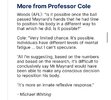- Dec 9, 2015
- 11,064
- 18,541
- AFL Club
- Collingwood
Finally some sanityTHE AFL has opted against appealing the Tribunal's decision in the Brayden Maynard case, meaning the Collingwood defender is in the clear to play in the Magpies' preliminary final.

AFL ponders rule change after Maynard Tribunal call
The Brayden Maynard saga is officially over after the AFL opted not to appeal the Tribunal's decisionwww.afl.com.au
The AFL, having brought the charge against Maynard, said on Wednesday that it would not challenge the Tribunal's ruling, but would comment further later in the day.
"The AFL has confirmed that after careful consideration and review of the Tribunal's decision and reasons following last night's hearing into the incident involving Collingwood's Brayden Maynard and Melbourne's Angus Brayshaw, the AFL has decided not to appeal the Tribunal's decision," a statement read.
"Per the Tribunal Guidelines the AFL had to make this decision by 12:00pm AEST today.
"The AFL will release a further statement later today."






